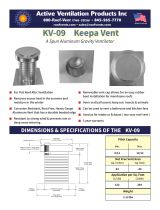
Revised 6/11/18 Copyright © 2018 Trade-Wind Manufacturing, LLC Proverbs 22:29 Page 8
Best Practices
Venting Installation Instructions
Addendum to Installation
Instructions
Model: 7200 Series
IMPORTANT: Problems caused by improper installations are not covered by the manufacturer’s warranty.
IMPORTANT: Undersized and improperly installed duct pipe and/or other ventilation components will cause excessive static
pressure (air resistance), that may result in rattling, vibration and air buffeting noises, as well as inadequate ventilation.
1. Building Codes
BBQ Hood Ventilators should be installed by qualified technicians familiar with state and local building codes.
2. Duct Pipe and Fittings (Elbows, Transitions, Roof & Wall Caps)
a. Use round or rectangular rigid metal duct only. Where possible, use round duct as it creates the least amount of
static pressure. DO NOT use flex duct.
b. All duct sections and fittings (EXCEPT DAMPERS, per Section 4), should overlap and be connected with at least 3 – 4
equally spaced screws and wrapped tightly with 2 – 3 layers of Aluminum Foil Metal Duct Tape. This type of duct
tape is more durable than traditional cloth duct tape. DO NOT use butt joints.
c. For best air flow, elbows and pipe size transition fittings should not be directly connected to one another. Where
possible, always include at least 15 inches of straight pipe between fittings.
3. Duct Pipe and Fitting Sizes
IMPORTANT: No portion of any length of duct pipe or fitting should be smaller than the discharge port of the ventilator.
This is very important because any type of restriction anywhere in the ventilation system will cause increased static
pressure (air resistance), that may result in rattling, vibration and air buffeting noises, as well as inadequate ventilation.
See Duct Sizing Chart and Area Calculations section for more detail.
Duct Runs – Length
a. Configure the ventilation duct run to be as short and as direct to the outside as possible. Minimize the number of
elbows and transition fittings used. Complex or long runs should be reviewed by a qualified installer.
b. No portion of the ducting should be run so that the exhaust air flows downward. Since exhaust heat rises, forcing
the air to flow downward will cause increased static pressure. As previously mentioned, improperly installed duct
pipe will cause excessive static pressure (air resistance), that may result in rattling, vibration and air buffeting noises,
as well as inadequate ventilation.
c. Duct runs for 1200CFM ventilator models should not exceed 35 linear feet with two 90-degree elbows and two 45-
degree elbows, a damper and a roof or wall cap. Longer runs or additional elbows will result in decreased
ventilation performance. Each 90-degree elbow is the equivalent of 6 linear feet of duct pipe; each 45-degree elbow
is equivalent to 3 linear feet of duct pipe.
d. Always run ventilator ducts to the outdoors. DO NOT terminate a duct into an attic, basement, garage, crawl space
under a house, a chimney, other ducting or an enclosed room.
4. Dampers
IMPORTANT: DO NOT USE ANY TYPE OF DAMPER IN A BBQ HOOD APPLICATION.
In ventilation systems utilizing a roof cap or wall cap with a built-in damper, remove it. Dampers are unnecessary and will
cause increased static pressure (air resistance), that may result in rattling, vibration and air buffeting noises, as well as
inadequate ventilation.












